 |
 |
 |
| |
Analysis of the Protease Inhibitor/Reverse Transcriptase Inhibitor/Fusion Inhibitor Resistance Pattern of Treatment-emergent CXCR4-using Virus from Six Patients in the MOTIVATE Studies Shows no Evidence of Different Drug Resistance Profiles Being Archived in the CCR5-tropic versus CXCR4-using Populations
|
| |
| |
Reported by Jules Levin
3rd International Workshop on Targeting HIV Entry
Washington, DC, USA, December 7-8, 2007
Marilyn Lewis, Paul Simpson, Elna van der Ryst, Mike Westby
Pfizer Global Research and Development, Sandwich, Kent, UK
AUTHOR SUMMARY
--Baseline protease, RT, and gp41 mutations were consistent with documented treatment history
--The selection of specific protease, RT and gp41 mutations on-treatment was consistent with the antiretrovirals used in the OBT
--There was no evidence that the CXCR4-using virus had escaped the selection of resistance mutations seen in the baseline R5 virus
--There was no evidence of different resistance profiles archived or emerging in the CXCR4-using virus population
BACKGROUND
--In the MOTIVATE 1 and 2 clinical trials 45-47% of treatment-experienced patients achieved HIV-1 RNA <50 copies/mL over 48 weeks of treatment with maraviroc plus optimized background therapy (OBT) versus 16-18% who received placebo plus OBT1,2
--In patients receiving maraviroc, CXCR4-tropic (X4) or dual/mixed-tropic (D/M) virus was detected in 76 of 188 patients failing treatment1
--In patients receiving placebo, CXCR4-using virus (X4 or D/M) was detected in 6 of 111 patients failing treatment1
--Detailed analysis of 192 baseline clones and 48 on-treatment clones from 20 patients in whom X4 or D/M virus emerged indicated that this CXCR4-using virus was derived from a pre-treatment reservoir3
1Lalezari J, et al. 47th ICAAC 2007; Presentation H-718a
2Fätkenheuer G, et al. 11th EACS 2007; Presentation PS3/5
3Lewis M, et al. XVI HIV Res Wkshp 2007. Abstract 56
CXCR4-using Virus was Derived from a Pre-treatment Reservoir
--In 14 patients, on-treatment D/M or X4 virus was detected at baseline
--In 6 patients, on-treatment CXCR4-using virus was not detected amongst the 192 envelope clones screened at baseline
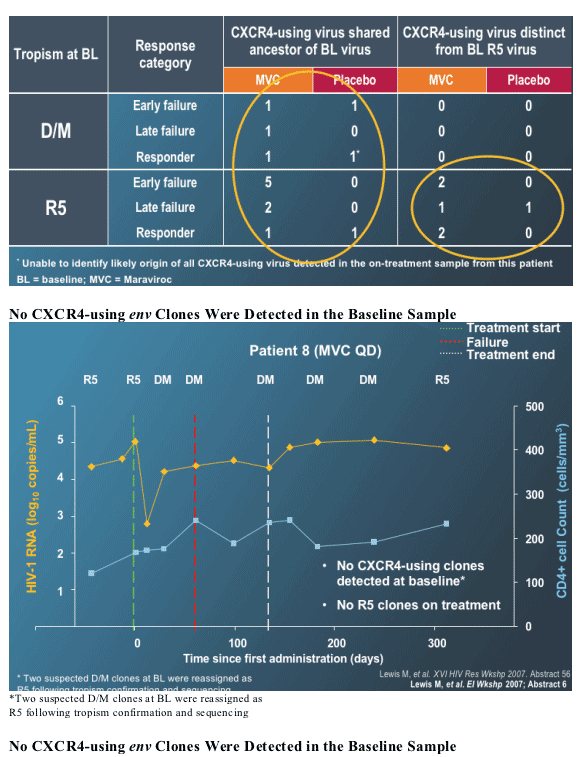
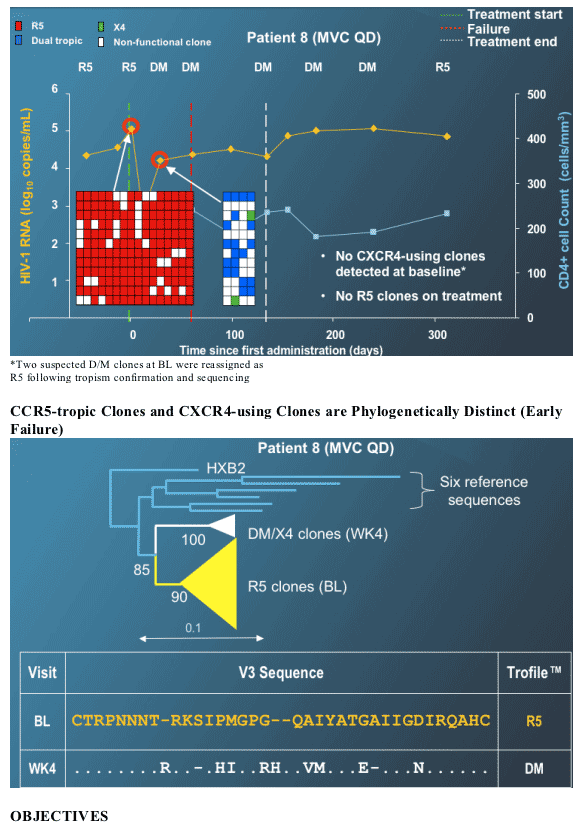
The objective of this analysis was to compare pre-treatment and on-treatment viruses for these six patients, to see if the R5 and CXCR4-using virus populations shared the same resistance patterns for
-Protease inhibitors (PI)
-Reverse transcriptase inhibitors (RTI)
-Enfuvirtide (ENF)
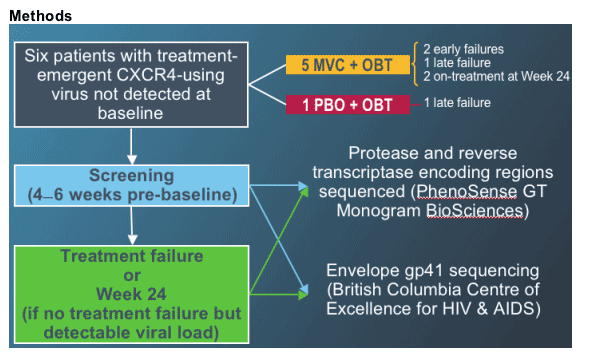
Baseline Resistance was Consistent with Treatment Experience
Virus at screening typically showed evidence of drug resistance to three or four drug classes, consistent with patients being heavily treatment experienced
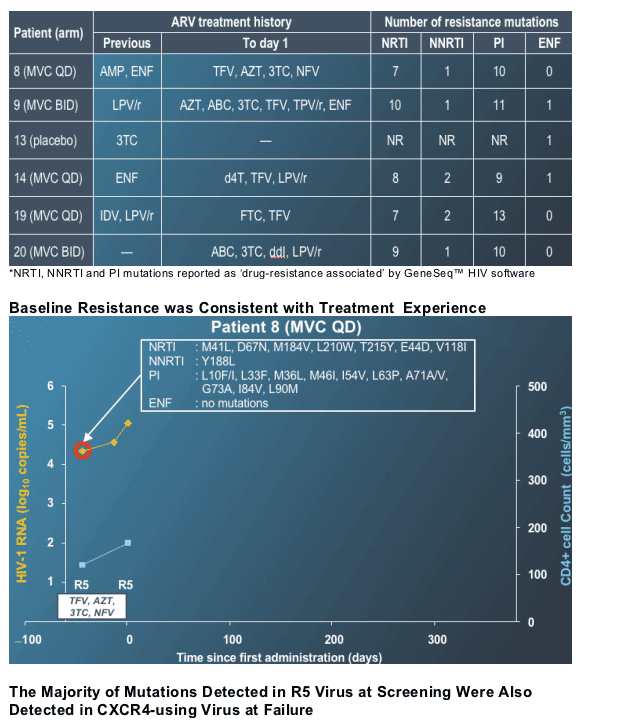
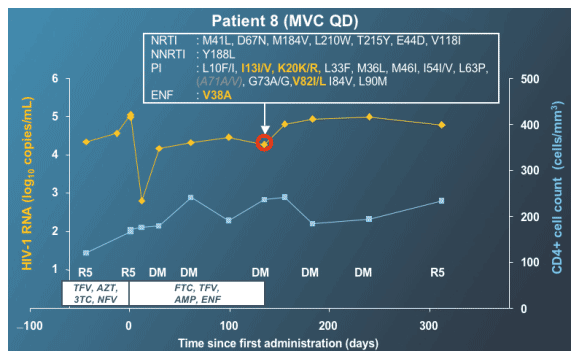
Most Differences Between Screening R5 Virus and
On-treatment CXCR4-using Virus Occurred in the Protease Gene
Differences were typically minor resistance/accessory mutations selected on a background of PI resistance mutations
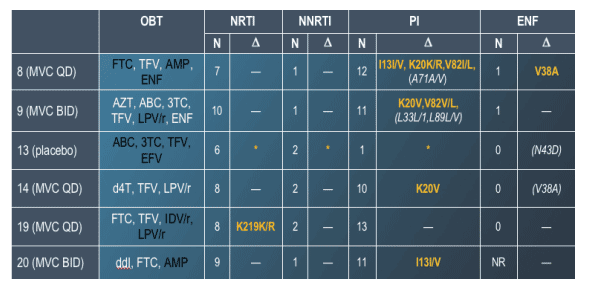
* No genotype was available for virus from this patient at screening
NRTI, NNRTI, and PI mutations reported as 'drug-resistance associated' by GeneSeq HIV software
D, change from screening - mutations no longer present or new mutations
The Selection of Mutations On-treatment was Consistent with the Antiretrovirals used in the OBT
Differences were typically minor resistance/accessory mutations selected on a background of PI resistance mutations
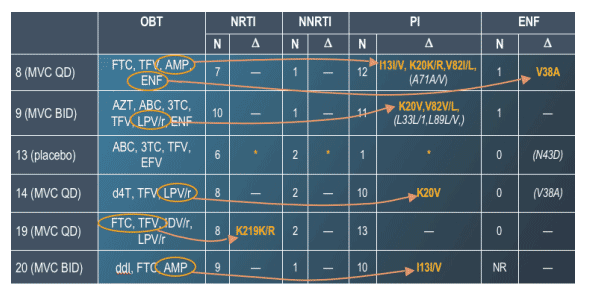
* No genotype was available for virus from this patient at screening
NRTI, NNRTI, and PI mutations reported as 'drug-resistance associated' by GeneSeq HIV software
D, change from screening - mutations no longer present or new mutations
|
| |
|
 |
 |
|
|